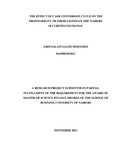| dc.description.abstract | Cash conversion cycle is a concept that is receiving serious attention all over the world especially with the current financial situations and the state of the world economy. The concern of business owners and managers all over the world is to devise a strategy of managing their day to day operations in order to meet their obligations as they fall due and increase profitability and shareholder’s wealth. Cash conversion cycle, in most cases, are considered from the perspective of working capital management as most of the indices used for measuring corporate liquidity are a function of the components of working capital. The purpose of this paper is to investigate the relation between a firm’s cash conversion cycle and its profitability.
The relation between the firm’s cash conversion cycle and its profitability is examined using dynamic panel data analysis for a sample of firms listed on The Nairobi Securities Exchange for the period from 2008 to 2012. The analysis is applied at the levels of the full sample and divisions of the sample by industry and by size.
A strong negative relation between the length of the firm’s cash conversion cycle and its profitability is found in all of the authors’ study samples except for consumer goods companies and services companies. Our results indicated that there is a significant and negative relationship between the cash conversion cycle and return on asset. The firms with shorter cash conversion cycles are more likely to be profitable than firms with longer cash conversion cycles. A possible explanation to this finding is that when the cash conversion cycle is relatively shorter, the firm may not need external financing, which results in incurring less borrowing cost and interest expense, hence increasing profitability.
The operating cash flow ratio can be used to compare companies across a sector, and to look at changes over time. Generally, a higher ratio is preferred, but as with all liquidity ratios, sector norms and the peculiarities of each business need to be taken into account. The power of cash flow analysis is enhanced by comparing ratio results to industry averages or to at least a select group of comparable organizations. Useful insights can also be developed by reviewing year-to- year trends in the ratios of an organization over time. Cash conversion cycle measures the time lag it takes company’s investment in raw material to be realised. Management should strive to maintain a very low CCC. | en |

